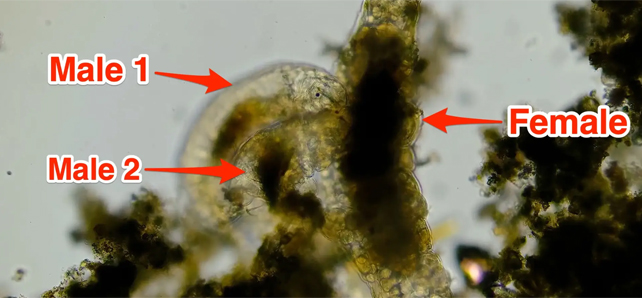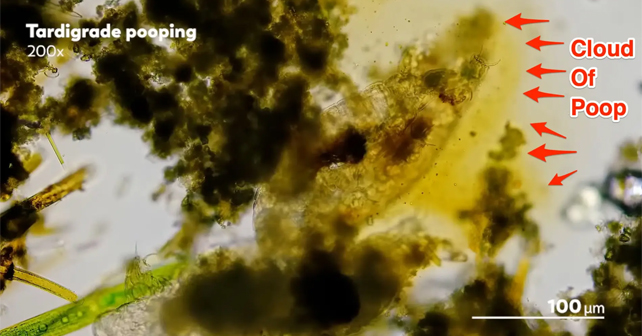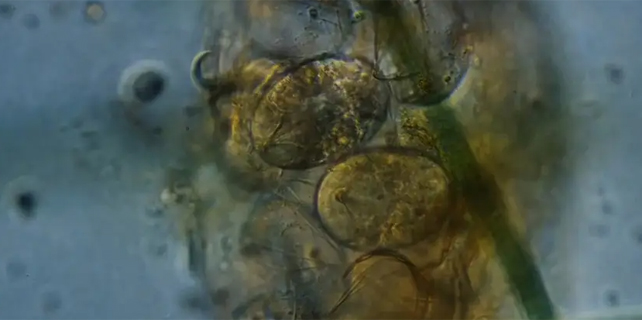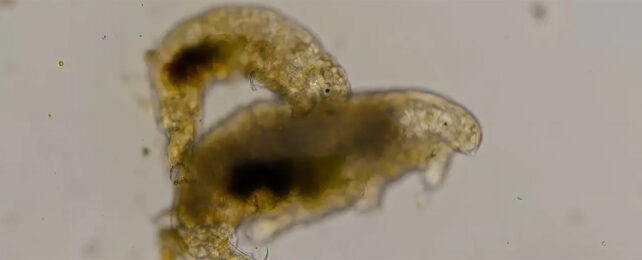Tardigrades are microscopic creatures with a gift for survival. These aquatic invertebrates – aka water bears or moss piglets – can withstand exposure to high levels of radiation, the crushing pressure of the deep sea, and even the vacuum of space.
We've also learned water bears have some pretty wild sex, thanks to recent video footage from scientist James Weiss, the videographer for the YouTube channel Journey to the Microcosmos and author of "The Hidden Beauty of the Microscopic World."
Weiss, who is an expert on using microscopes to study microbes in ponds, lakes, rivers, and seas, created sealed environments on slides to observe the same water bears for weeks. That's how he captured footage of tardigrades mating for up to two hours at a time.
He also recorded a 30-minute tardigrade threesome – one of the first known recordings of tardigrade group sex.
A water bear threesome
Researchers first published details of tardigrade mating behavior in a 2016 paper, but other observations of water bear sex remains fairly limited.
"There weren't many people studying tardigrades until very recently, so all these observations are coming from a couple of renowned tardigradologists," Weiss said. (Yes, "tardigradologist" is a real word, he added.)

"I don't study tardigrades in a traditional, institutional way, but since I've been interested in them for a long time, I've gathered a lot of data and observed unique behaviors," Weiss said.
One of those unique behaviors? A water bear threesome.
While observing tardigrades on his slides, Weiss first noticed two smaller tardigrades who seemed drawn to a larger tardigrade's underbelly. This was unusual, since typically, tardigrades don't show such a focused interest on anything.
But even after 20 minutes, the two smaller tardigrades kept prodding the larger one with their mouths. Weiss, who isn't a tardigrade expert but has seen enough of them in his studies of microscopic creatures, noticed that the larger tardigrade looked like it was carrying unfertilized eggs.

He said that the two smaller tardigrades were males "shooting their shot" in an effort to fertilize the female's eggs.
As Weiss watched, he said the two males continued jabbing the female as she pooped, which Weiss suggested could be a way to attract males.
Weiss added, though, that experts' limited understanding of tardigrade sex makes it impossible to be sure exactly why she defecated.
"In water, everything is about chemical cues, so males have to gather some information to find females," Weiss said.
To test this, Weiss separated some mating couples by gently poking them with some cat hair through the microscope slide and coverslip. In each instance, the males returned to the females within just a couple of minutes.

"So I believe there's some chemical signaling happening, and well, pooping releases a lot of signals into the water," Weiss said.
After about 30 minutes in all, the threesome became a twosome when one male departed the scene.
The remaining male stuck with the female for an additional hour, and Weiss observed similar mating behavior with other tardigrade couples on the slide.
Water bear reproduction
Males are attracted to females with unfertilized eggs, or oocytes.
In his book, Weiss observed that males always seem to do the pursuing. "While females calmly grazed on algae, males were running around like crazy chickens and hopping on females' backs and staying there for an hour and a half," he wrote.
Once the males find a female, they cling to her with their claws and the partners make a wild rhythmic motion until eventually the male finishes, releasing thousands of sperms that likely fertilize the eggs by entering an opening in the female's exoskeleton.
But scientists have yet to discover exactly how fertilization happens.
Not all water bears need to have sex to reproduce. Weiss said some species of tardigrades only include females, who reproduce asexually via parthenogenesis.
He also said it's possible that tardigrades may switch reproduction methods when under environmental stress, though experts still have a lot more to learn about this theory.
But marine species of water bears, like the species Weiss recorded, include both males and females, and they reproduce by mating.
Water bear birth
A water bear mother might carry 20 or so eggs until the eggs start hatching one by one – popping like popcorn, Weiss said.

"It's easy to distinguish a newborn tardigrade because they have empty bellies. Just after a week, they're ready to reproduce, so it's safe to say the babies have babies in two weeks after hatching," Weiss said.
Water bears have fairly short lives, with 8 weeks being the longest lifespan Weiss has observed in his research.
Watch the tardigrade threesome in the below video, starting around timestamp 13:25.

This article was originally published by Business Insider.
More from Business Insider: